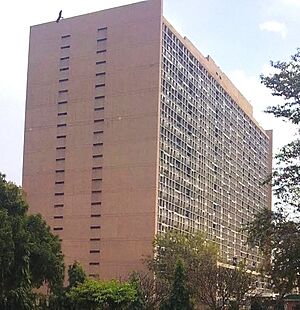State Bank of Pakistan facts for kids

Seal of the State Bank of Pakistan
|
|

Headquarters of the State Bank of Pakistan
|
|
| Headquarters | I. I. Chundrigar Road, Serai Quarter, Karachi-74000, Pakistan |
|---|---|
| Established | 7 January 1948 |
| Ownership | 100% state ownership |
| Governor | Jameel Ahmad |
| Central bank of | |
| Currency | Pakistani rupee (₨) PKR (ISO 4217) |
| Reserves | |
| Reserve requirements | |
| Bank rate | ▼ 15% |
| Interest rate target | ▼ 16.5–18.5% |
| Interest on reserves | ▼ 16.5% |
| Preceded by | Reserve Bank of India |
| Succeeded by | Bangladesh Bank (1971, in Bangladesh) |
The State Bank of Pakistan (SBP) is like the main bank for the country of Pakistan. It's in charge of making sure the country's money system works well. This includes printing bank notes and keeping the economy stable.
The bank's main office is in Karachi, which is a big financial city in Pakistan. The SBP also has a special part called SBP Banking Services Corporation (SBP-BSC). This part has offices in 16 cities across Pakistan, including the capital Islamabad and the main cities of the four provinces: Lahore, Karachi, Peshawar, and Quetta.
The State Bank of Pakistan also owns other important groups. These include the National Institute of Banking and Finance, which trains people in banking, and the Deposit Protection Corporation. It also owns the Pakistan Security Printing Corporation, which prints money.
Contents
History of the State Bank
How Pakistan's Central Bank Started
Before Pakistan became an independent country on August 14, 1947, the Reserve Bank of India was the main bank for the whole area. After Pakistan gained independence, the money and reserves from the Reserve Bank of India were split between Pakistan and India. Pakistan received 30 percent of these reserves.
In May 1948, Muhammad Ali Jinnah, who was the founder of Pakistan, decided that Pakistan needed its own central bank right away. So, the State Bank of Pakistan officially started its work on July 1, 1948.
Early Goals of the SBP
When it first started, the State Bank of Pakistan was given the job to "control the printing of bank notes and keep money safe. This was to make sure Pakistan's money system stayed stable. It also had to manage the country's money and credit system for the country's benefit."
At the beginning, many industrial families helped fund the State Bank. They would give a part of their yearly profits to help the bank run. The Valika Family was one of the biggest helpers.
Growing Responsibilities of the Bank
The State Bank's duties grew a lot when the State Bank of Pakistan Act of 1956 was introduced. This law said the bank should "manage Pakistan's money and credit system. It also needed to help the country's economy grow in the best way. This was to make sure money stayed stable and all of the country's resources were used fully."
In February 1994, the State Bank was given more freedom to make its own decisions. This happened during a time when Pakistan was making big changes to its financial system.
More Freedom for the SBP
On January 21, 1997, the bank became even more independent. The government made new laws that gave the State Bank full power to control the banking sector. It could also set its own monetary policy (how much money is in circulation) and limit how much the government could borrow from it.
These changes also made the leaders of nationalized banks and financial groups more responsible. The State Bank now had a say in who was chosen for these important jobs.
What the State Bank Does Today
The State Bank of Pakistan does many things to help the country's economy. These include:
- Issuing notes: Printing and managing the country's money.
- Supervising banks: Making sure other banks follow the rules.
- Banker to banks: Acting as a bank for other banks.
- Lender of last resort: Helping banks if they run into financial trouble.
- Banker to the Government: Managing the government's money.
- Monetary policy: Deciding how much money is available in the economy.
The bank also helps manage public debt and foreign money. It advises the government on money matters and works with international financial groups.
The State Bank also helps develop the financial system, encourages saving and investing, and provides training for bankers. It also helps provide loans to important parts of the economy. The bank has also been working to make the banking system follow Islamic rules.
The SBP is also working to make sure more people have access to banking services. It is a key member of the Alliance for Financial Inclusion. In 2019, the SBP started a plan to create a modern digital payment system for Pakistan.
In July 2025, the State Bank of Pakistan decided to keep its main interest rate at 11%. This was because prices were stable and the economy was getting a little better. Even though Pakistan had more money coming in than going out in 2023, the SBP now expects to spend more than it earns this year. This is because imports are increasing. While money sent home by Pakistanis living abroad and exports have grown, the rise in non-oil imports and expected increase in prices show that the economy still has some challenges. Economic growth is expected to be between 3.25% and 4.25%, but the situation is still a bit uncertain.
Managing Money in the Economy
The State Bank of Pakistan is in charge of managing the country's money and credit. It does this to help the government reach its goals for economic growth and keeping prices stable.
The bank controls how much money is available and where it goes in different parts of the economy. It uses various tools to do this. In the 1980s, Pakistan made big changes to its financial system. These changes helped the State Bank move from direct controls to using market-based methods to manage money.
The State Bank of Pakistan has also changed the look of many bank notes in Pakistan. These changes were made to help stop fake money from being used.
Banking Services and Oversight
The State Bank of Pakistan looks at many different areas of banking. This helps it deal with changes in the economy and how people buy and sell things. Here are some of the banking areas the bank focuses on:
- Approving rules for Islamic ways of financing.
- Rules for getting back unclaimed money from banks.
- Watching over the banking sector in Pakistan.
- Helping small loans (microfinance).
- Supporting Small and medium enterprises (SMEs).
- Setting minimum money requirements for banks.
- Making it easier to send money (remittances) in Pakistan.
- Rules for opening foreign money accounts.
- Guidelines for how companies should be run.
- Guidelines for managing risks.
- Guidelines for commercial paper and securitisation.
- A special plan for helping with farm loans.
Bank Money and Debts
This table shows how much money banks in Pakistan held and owed, reported to the State Bank of Pakistan. The numbers are in millions of Pakistani rupees.
| Year | Deposits |
|---|---|
| 2020 | 17,875,958 |
| 2021 | 20,972,043 |
The State Bank also handles:
- Legal services for banking.
- Its own library.
- Payment systems.
- The Real Time Gross Settlement (RTGS) system, which processes large payments quickly.
- Support for small and medium businesses.
- Training and Development Department (TDD).
- Managing the bank's own money (treasury operations).
- Planning for the bank's future.
- Microfinance.
- The Pakistan Remittance Initiative, which helps people send money.
- Information Systems and Technology Department.
- Risk Management Department.
How Currency is Managed
The State Bank of Pakistan allows other banks to use special companies to sort, check, and pack banknotes.
Governor of the SBP
The most important person at the State Bank of Pakistan is the Governor. Jameel Ahmad is the current Governor as of 2022.
Board of Directors
The Board of Directors helps lead the State Bank. It has ten members: the Governor (who is the Chairman), the Secretary of the Finance Division from the Government of Pakistan, and eight other Directors. One Director comes from each of Pakistan's provinces. These Directors are chosen by the government for three years.
The current Board of Directors includes:
- Murtaza Syed (Acting Governor SBP)
- Arif Ahmed Khan (Secretary Finance)
- Tariq Hassan
- Hafiz Mohammad Yousaf
- Zubyr Soomro
- Khawaja Iqbal Hassan
- Ardeshir Khursheed Marker
- Bairum Khan
- Sarmad Amin
- Laiba Sengsy
Museum
The State Bank of Pakistan also has a museum and art gallery.
See also
 In Spanish: Banco Estatal de Pakistán para niños
In Spanish: Banco Estatal de Pakistán para niños
- Governor of State Bank of Pakistan
- National Bank of Pakistan
- Pakistani Rupee
- Pakistani 75-rupee note
- Banking in Pakistan
- Raast
- 1LINK
- List of central banks

